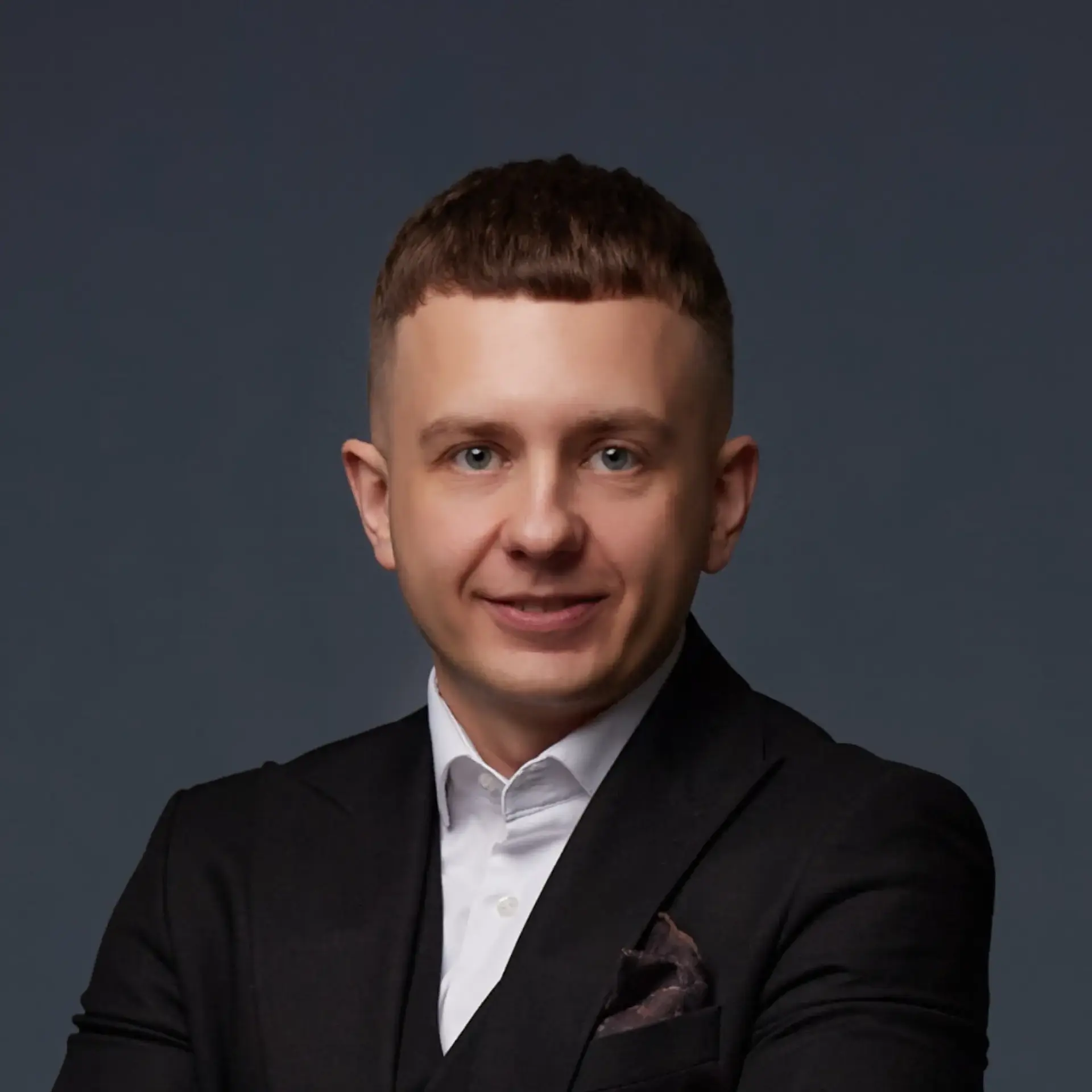What Is a Principal Software Engineer & Why You Should Hire One

Less than 1 in 100 software engineers reach the management level, yet those who do often influence decisions involving millions in product value and operating expenses. This rare combination of strategic insight and deep technical mastery makes them indispensable and explains why companies compete fiercely to hire them. According to Built In, the average principal software engineer salary in the United States stands at $171,400, nearly double that of many mid-level roles.
Curious what makes these professionals so valuable, and how hiring software developers at this level works? Read our full article to explore the role, responsibilities, and business impact of a principal software engineer.
What is a principal software engineer?
A principal software engineer holds one of the most advanced technical roles in the software development industry. This role goes beyond seniority. It involves leading complex software development projects, setting technical direction, and working with leadership to align development with business goals.
Principal engineers shape architecture, define standards, and ensure systems scale properly. Their influence comes from deep knowledge, clear judgment, and consistent delivery. They identify risks early, guide teams through complex concepts, and support product and design functions with strong technical input.
Drawing on Relevant Software experience, principal engineers drive value across the full lifecycle. From early design to deployment and long-term maintenance, they help companies make better technical decisions and deliver stronger results in custom web development.
The business value of hiring a principal engineer
If you hire a principal software engineer with a strong background and relevant certification, you gain both a hands-on expert and a strategic thinker. This role brings clear technical direction, better system design, and stronger team performance, along with the necessary qualifications, all of which help your product move faster and scale more smoothly.
Here’s what you get:
- A solid technical foundation that removes architectural risks early and avoids costly mistakes later
- Faster development through cleaner systems and fewer delays caused by rework
- A direct link between product goals and technical execution, so teams build what the business actually needs
- Higher software quality thanks to consistent design principles and better-integrated systems
- A stronger team, as your senior engineers receive mentorship and grow into technical leaders themselves
With a principal engineer on board, organizations gain clarity, stability, and sustained velocity – outcomes that often exceed the impact of multiple mid-level hires.
What are the software engineering levels?
Understanding software engineering levels helps clarify where the principal software engineer fits in the hierarchy. While titles can vary slightly between companies, most follow a similar structure. Here’s a breakdown of the standard software engineer levels used across leading tech firms:
Level 1: Software engineer
At this level, engineers contribute to specific features and follow clear technical direction. They learn internal tools, study the codebase, and complete well-defined tasks. Progress depends on how well they improve code quality, write tests, and collaborate with others.
Level 2: Senior engineer
A senior engineer owns a part of the system. They lead small teams through delivery, handle system improvements, and manage technical debt in their area. They help shape feature development and take part in technical discussions beyond their immediate scope.
Level 3: Staff engineer
Staff engineers operate across teams. The work of a principal software development engineer includes architecture, planning, and coordination of software solutions. They take ownership of entire systems or domains and guide technical decisions that affect several teams. In many cases, they help define platform strategy and lead incident response for critical services.
Level 4: Principal engineer
A principal software engineer bridges the gap between technology and business at the highest level. Their scope extends across the entire product line. They define the architecture, align technical choices with strategic goals, and shape how engineering operates as a whole. Their peers include heads of departments and executive stakeholders.
Level 5: Distinguished engineer / Fellow
This tier includes engineers who influence at the company or industry level. They lead foundational research, establish new standards, and shape engineering culture over time. Their work often involves platform transformation, innovation programs, or long-term technical strategy.
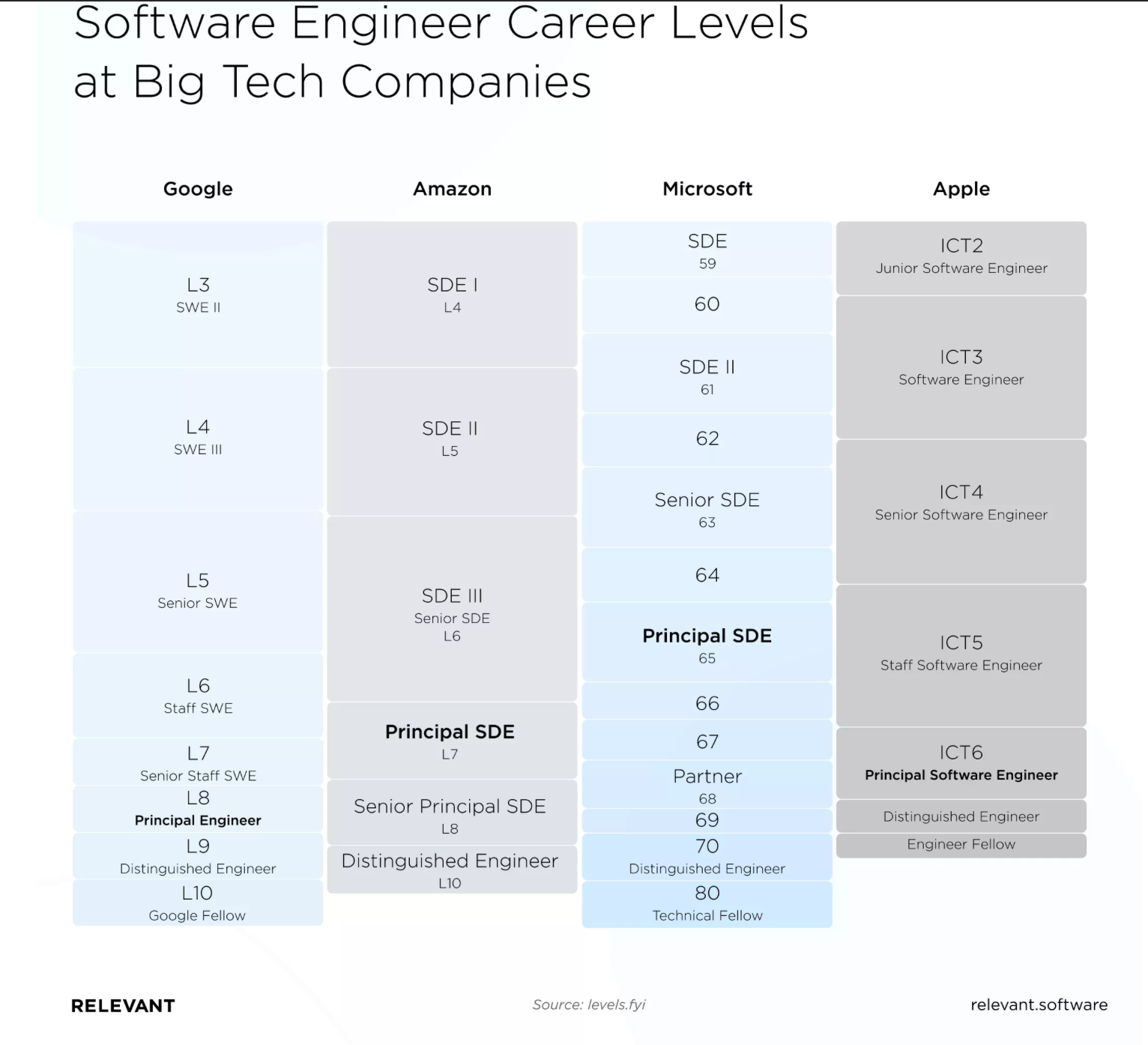
Source: levels.fyi
Key traits of a successful principal engineer
A principal software engineer is measured not by seniority alone, but by the ability to move systems, teams, and strategy forward with discipline, clarity, and a commitment to continuous learning. The role demands depth over volume, influence over control, and outcomes over activity.
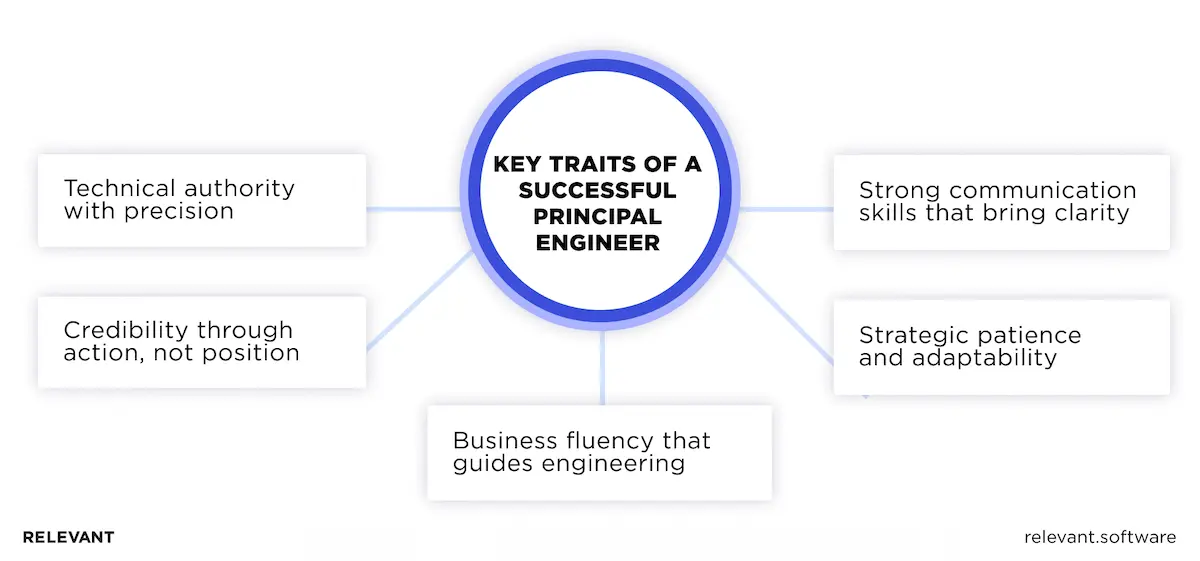
1. Technical authority with precision
This engineer sees the system as a whole and knows where it will break. They assess code not only for correctness, but for cost, stability, and long-term trade-offs. Their decisions reduce friction for others and give the architecture room to scale without constant intervention.
2. Credibility through action, not position
Principal engineers lead by example, not by title. They spot problems early, choose practical solutions, and follow through with discipline. Their decisions raise the standard for the whole team. Instead of chasing attention, they earn trust through consistent results.
3. Strong communication skills that bring clarity
A principal engineer must explain complex ideas in a simple, direct manner. Whether they speak with executives or offer feedback to peers, their words remove ambiguity. They ask precise questions, focus on outcomes, and help the team align around shared goals without confusion or noise.
4. Strategic patience and adaptability
They read the room, follow business priorities, and know when to push for change and when to keep systems steady. Instead of reacting to trends or pressure, they guide teams with clear steps, adjust based on context, and protect quality without breaking core principles.
5. Business fluency that guides engineering
They don’t just ask what to build; they ask why it matters. A strong principal engineer understands which trade-offs the business can afford and which ones it can’t. They ground technical proposals in commercial impact and adjust direction when the landscape shifts.
These traits separate a strong senior engineer from a true principal. While senior engineers solve well-defined problems, principal engineers define the problems worth solving and scale their impact across multiple teams.
Principal software engineer responsibilities
A principal engineer must stay fluent in the programming languages used across the team’s stack. They provide direct guidance on system performance, scalability, and long-term support. They take full responsibility for technical direction across software projects and systems. Each decision reflects best practices and supports long-term product growth.
Unlike a software architect, a principal software developer remains closely involved with the codebase. They shape design choices across teams, plan system structure, solve complex problems, and mentor engineers to raise the standard of technical output.
Typical principal software engineer responsibilities include:
- Write clean, reliable code and resolve critical issues with precision and speed
- Align system design with business goals to guide product evolution
- Support development teams with deep technical insight on complex challenges
- Mentor senior and mid-level engineers to improve overall team strength
- Assess new technologies that improve product strategy or reduce future costs
- Lead code reviews and uphold engineering standards across all teams
- Supervise technical work to ensure each release meets scope and timeline
- Act on user feedback to drive focused product improvements
In some companies, the line between principal software engineer vs architect may blur. Understanding how this role compares to others is essential. If you choose between an architect vs principal engineer, consider this: the architect defines high-level structure but often operates at a distance from daily development. The principal engineer stays close to implementation, reviews code, contributes to complex systems, and guides teams through major decisions.
When comparing a principal vs senior software engineer, the key distinction lies in scope. A senior engineer typically owns a specific component or service. A principal engineer oversees the platform as a whole, mentors senior peers, and aligns engineering with long-term strategy.
Finally, the principal software engineer vs technical lead distinction often centers on focus and influence. A technical lead manages delivery for a project or squad and supports coordination. A principal engineer works across teams and domains, shaping architectural decisions and maintaining consistency across systems. They influence the technical direction of the company beyond a single team’s output.
Recruitment process for a principal software engineer
Finding senior engineers is getting slower and more competitive. On average, U.S. companies now spend 35 to 40 days filling software roles, and that’s for mid-level positions. Hiring a principal software engineer often takes longer. The talent pool is limited, and evaluations run deep. Demand, however, keeps rising. By late 2026, the U.S. could be short more than 1.2 million software developers.
If your hiring process drags or lacks clarity, you risk losing the right person. Good engineers move on quickly. A clear, structured process not only shortens timelines but also shows that your company values strong engineering.
So, how do you hire a principal developer without delay? Start with a tighter approach. Whether you recruit directly or engage a dedicated team, the right structure helps you move fast and secure top talent before competitors step in.
Recruitment process steps
The recruitment process must test technical depth, architectural judgment, and leadership ability. Avoid generic coding tests or surface-level interviews. Focus on real experience, system-level decisions, and how candidates solve problems in real product environments.
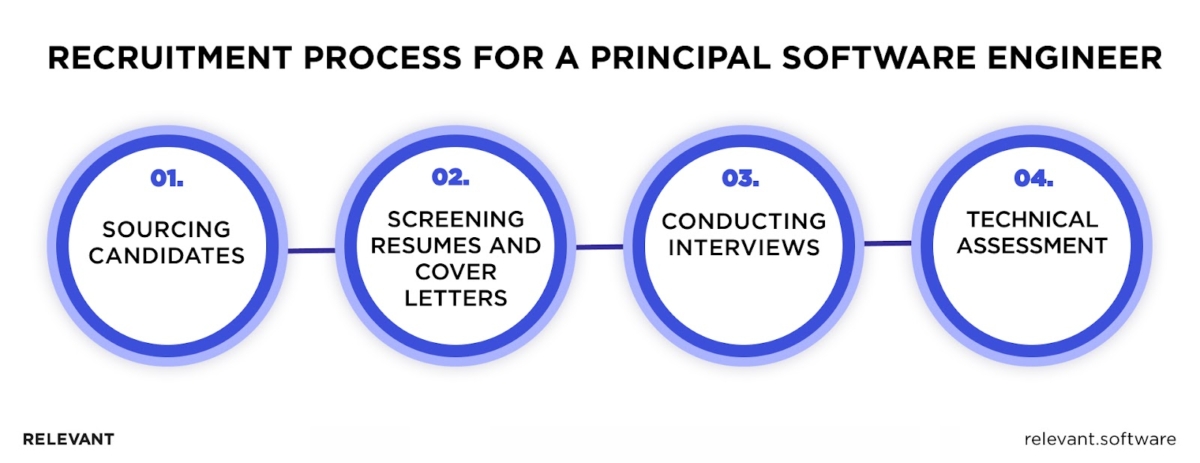
Sourcing candidates
Look beyond traditional job boards and consider participating in industry events. Senior candidates often avoid mass-market listings. Use professional networks, engineering communities, and direct outreach. If you plan to work with an external partner, make sure they understand the distinction between senior execution and principal-level ownership.
Screening resumes and cover letters
Look for past roles where the candidate led cross-team technical efforts, improved system performance, or mentored senior engineers. Strong candidates in principal software engineer jobs often show impact at the system level, not just within a single product feature.
Conducting interviews
Structure interviews around real scenarios. Ask candidates to walk through key decisions they made in past roles. Explore how they handled conflict, reviewed design trade-offs, or aligned engineering with business goals. Keep the focus on how they think, not just what they know.
Technical assessment
Skip algorithm puzzles. Instead, provide a high-level system challenge. Ask the candidate to map out an architecture, identify risks, and explain trade-offs. This step helps you see how they think under pressure and how well they connect technical plans to business outcomes.
By following a structured hiring approach, companies avoid costly mis-hires and attract engineers who can lead, deliver, and scale mission-critical systems. Whether you’re building an internal team or looking for a principal software developer for hire, a clear process helps you reach the right outcome faster.
Relevant Software clients rely on this same approach. From fast-growing startups to enterprise platforms, they trust us to provide talent that fits not only the role but the roadmap ahead.
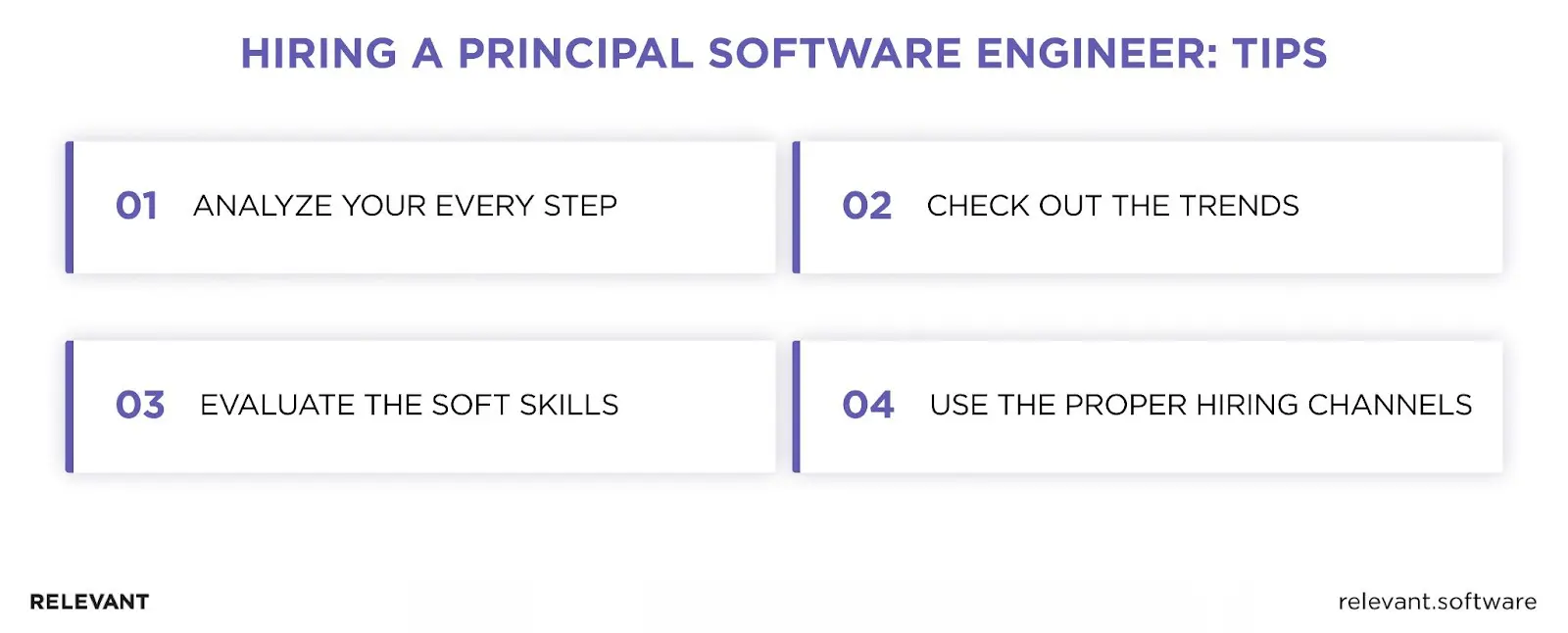
What are the сhallenges of hiring senior developers?
Hiring senior engineers is never easy. The deeper the skillset, the harder it becomes to find someone who fits both technically and culturally. Candidates with high qualifications are already employed, well-paid, and not actively looking. And when they do consider new roles, they come with high standards.
One major challenge is the size of the talent pool. There simply aren’t enough experienced developers with the leadership and system-level thinking needed for principal roles. This makes competition tough, especially if you’re hiring for principal software engineer jobs or looking to expand a team with dedicated software developers.
Another issue is clarity. If your team can’t explain how the role differs from, say, a senior software engineer or an architect, candidates may lose interest. Engineers at this level expect clear responsibilities, technical ownership, and a roadmap for impact.
Time is also a factor. Hiring for a senior or principal role typically involves multiple rounds of interviews, in-depth technical discussions, and coordination across various teams. This slows down the process, and the best candidates won’t wait forever.
Lastly, cost matters. Top-tier engineers expect strong compensation, but they also want meaningful work, strong peer relationships, and opportunities for growth. If any part feels weak, even a generous offer may fall short.
Success depends on more than filling a role. It requires trust, clear technical vision, and a process that respects the candidate’s time and experience.
Principal Engineer’s job description: example
Below is a sample principal software engineer job description you can adapt to match your team’s goals, technical needs, and hiring priorities:
“We’re hiring a principal software engineer to take the lead on complex systems as we scale. You’ll work closely with other engineers to solve deep technical problems, guide architectural decisions, and help teams stay focused and aligned.
What you’ll do
- Lead architectural design and define the system structure for major parts of the platform
- Collaborate with product and engineering leads to connect business goals with technical plans
- Review design proposals across teams and provide constructive feedback
- Set standards for how the team writes, tests, and ships code, then drive improvements
- Spot risks early and guide the team toward stable, scalable outcomes
- Mentor senior engineers and raise the technical bar while maintaining momentum
- Evaluate new tools or approaches in the related field when they add clear, practical value.
What we’re looking for
- Principal Software Engineer, years of experience 8+, including work on large, complex systems
- Degree in computer science, engineering, or a related field (preferred)
- Track record of shipping software that scales and performs under pressure
- Deep knowledge of system design, software architecture, and backend infrastructure
- Ability to lead discussions with both technical and business teams
- Steady, pragmatic approach to solving complex problems
- Experience as a mentor for engineers and as a guide across team boundaries
Bonus: background in areas like security, cloud infrastructure, or performance tuning.
This job post reflects the depth and scope of principal software engineer roles and responsibilities, and can be tailored to match your company’s specific technology stack, domain, and team structure.
Principal software developer interview questions
Here are some principal software engineer interview questions you can use to assess technical depth, architectural thinking, and leadership skills during the hiring process:
1. When a high-priority release is blocked by a critical architectural flaw, and the business refuses to delay, what’s your move?
This uncovers how the candidate balances technical integrity with business pressure.
2. Describe a situation where you inherited a poorly structured system. What were the first three things you did, and what did you leave alone?
Assesses judgment, prioritization, and real-world experience with technical debt.
3. What’s a piece of engineering advice you gave that was ignored, and what happened next?
Highlights communication, resilience, and how they handle leadership without authority.
4. How do you approach unplanned rewrites when teams are emotionally invested in the old system?
Looks at influence, empathy, and leadership in politically sensitive scenarios.
5. What metrics or signals tell you your architecture is breaking down, even if users haven’t complained yet?
Reveals maturity in system health, observability, and proactive thinking.
6. Walk me through a time you introduced a new programming language, platform, or tool to an existing team. What were the side effects, good and bad?
Tests risk management, onboarding strategy, and team-level impact.
7. Describe the last time you said no to something that would have made your own job easier. Why?
Uncovers principles, long-term thinking, and personal accountability.
8. What’s a design principle you’ve changed your mind about in the past two years?
Highlights intellectual honesty, evolution in thinking, and exposure to real-world outcomes.
9. When you disagree with the CTO on a technical direction, how do you handle it?
Explores conflict resolution, stakeholder management, and executive communication.
10. You join a new company where the engineers ship fast but break things often. How do you bring in structure without killing momentum?
Assesses change management, cultural awareness, and strategic influence.
How to hire a principal software engineer with Relevant Software
Hiring the right principal software engineer takes more than a job post and a few interviews. The talent market is tight, and companies compete for candidates who can shape architecture, guide teams, and deliver results. That’s why many turn to software development partners to find engineers who go beyond the resume.
At Relevant Software, we help companies build high-performing engineering teams. With over 10 years of experience, we know how to find principal-level talent who lead through action, own delivery, and strengthen long-term technical strategy.
When you hire through Relevant Software, you get:
- Senior engineers with real experience in architecture, system performance, and product delivery
- Help defining the role — so you understand key differences like principal vs. senior engineer
- Flexible hiring models, from individual software developers to full development teams
- Reliable onboarding that balances speed with quality
- Talent that fits your tools, workflows, and engineering culture
Do you need a principal engineer or a complete team? Let’s build it together. Contact us to get started.
